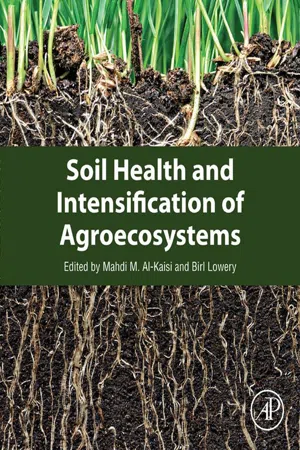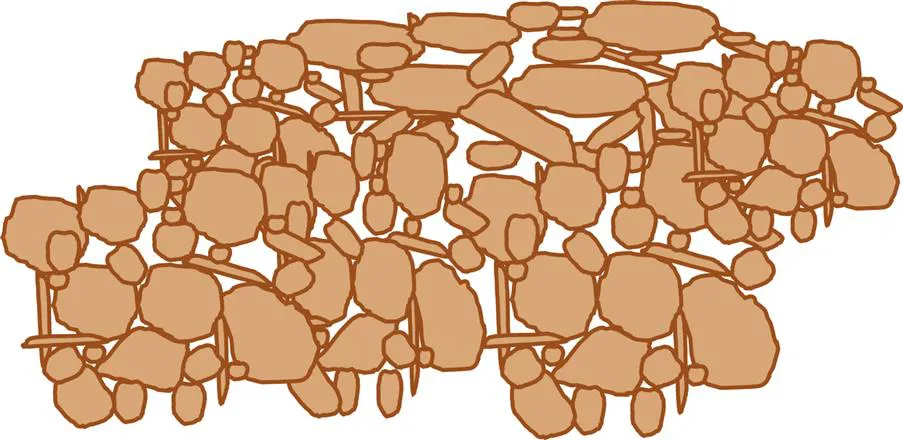
- 418 pages
- English
- ePUB (mobile friendly)
- Available on iOS & Android
Soil Health and Intensification of Agroecosystems
About this book
Soil Health and Intensification of Agroecosystems examines the climate, environmental, and human effects on agroecosystems and how the existing paradigms must be revised in order to establish sustainable production. The increased demand for food and fuel exerts tremendous stress on all aspects of natural resources and the environment to satisfy an ever increasing world population, which includes the use of agriculture products for energy and other uses in addition to human and animal food.The book presents options for ecological systems that mimic the natural diversity of the ecosystem and can have significant effect as the world faces a rapidly changing and volatile climate. The book explores the introduction of sustainable agroecosystems that promote biodiversity, sustain soil health, and enhance food production as ways to help mitigate some of these adverse effects.New agroecosystems will help define a resilient system that can potentially absorb some of the extreme shifts in climate. Changing the existing cropping system paradigm to utilize natural system attributes by promoting biodiversity within production agricultural systems, such as the integration of polycultures, will also enhance ecological resiliency and will likely increase carbon sequestration.- Focuses on the intensification and integration of agroecosystem and soil resiliency by presenting suggested modifications of the current cropping system paradigm- Examines climate, environment, and human effects on agroecosystems- Explores in depth the wide range of intercalated soil and plant interactions as they influence soil sustainability and, in particular, soil quality- Presents options for ecological systems that mimic the natural diversity of the ecosystem and can have significant effect as the world faces a rapidly changing and volatile climate
Frequently asked questions
- Essential is ideal for learners and professionals who enjoy exploring a wide range of subjects. Access the Essential Library with 800,000+ trusted titles and best-sellers across business, personal growth, and the humanities. Includes unlimited reading time and Standard Read Aloud voice.
- Complete: Perfect for advanced learners and researchers needing full, unrestricted access. Unlock 1.4M+ books across hundreds of subjects, including academic and specialized titles. The Complete Plan also includes advanced features like Premium Read Aloud and Research Assistant.
Please note we cannot support devices running on iOS 13 and Android 7 or earlier. Learn more about using the app.
Information
Fundamentals and Functions of Soil Environment
Abstract
Keywords
1.1 Introduction
1.2 Soil Properties and Interrelationships
1.2.1 Soil Physical Environment



Table of contents
- Cover image
- Title page
- Table of Contents
- Copyright
- List of Contributors
- Preface
- Chapter 1. Fundamentals and Functions of Soil Environment
- Chapter 2. Climate Variability Effects on Agriculture Land Use and Soil Services
- Chapter 3. Soil Health Concerns Facing Dryland Agroecosystems
- Chapter 4. Conservation Agriculture Systems to Mitigate Climate Variability Effects on Soil Health
- Chapter 5. Conventional Agricultural Production Systems and Soil Functions
- Chapter 6. Integration of Annual and Perennial Cover Crops for Improving Soil Health
- Chapter 7. Perennial-Based Agricultural Systems and Livestock Impact on Soil and Ecological Services
- Chapter 8. Intensified Agroecosystems and Their Effects on Soil Biodiversity and Soil Functions
- Chapter 9. Intensified Agroecosystems and Changes in Soil Carbon Dynamics
- Chapter 10. Agroecosystem Net Primary Productivity and Carbon Footprint
- Chapter 11. Nutrient Cycling and Soil Biology in Row Crop Systems under Intensive Tillage
- Chapter 12. Row-Crop Production Practices Effects on Greenhouse Gas Emissions
- Chapter 13. Low-Input and Intensified Crop Production Systems Effects on Soil Health and Environment
- Chapter 14. Agroforestry Practices and Soil Ecosystem Services
- Chapter 15. Targeted Use of Perennial Grass Biomass Crops in and Around Annual Crop Production Fields to Improve Soil Health
- Chapter 16. Biotechnology Impacts on Soil and Environmental Services
- Further Reading
- Glossary
- Index